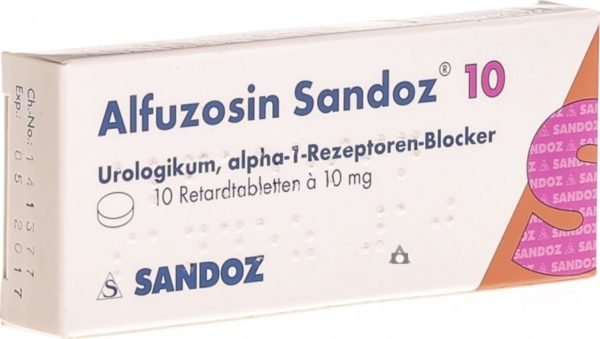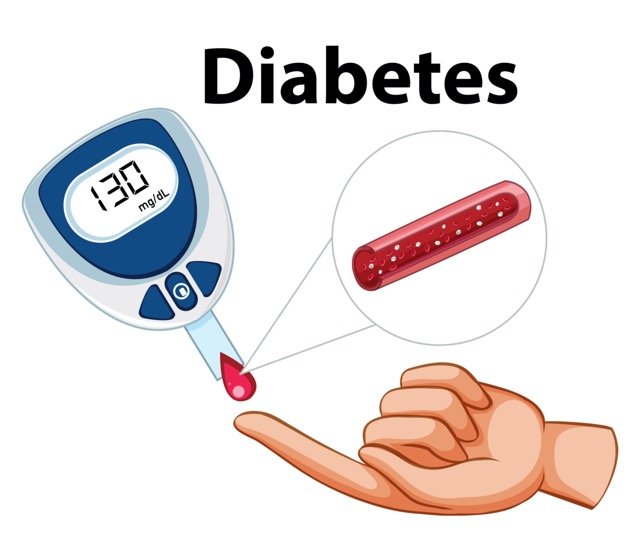Alfuzosin is a medication primarily used to treat benign prostatic hyperplasia (BPH), a condition in which the prostate gland becomes enlarged, leading to difficulties in urination. It belongs to a class of drugs called alpha-1 blockers, which work by relaxing the muscles in the prostate and bladder neck, making it easier to urinate.
Alfuzosin helps to relieve symptoms such as frequent or urgent need to urinate, weak stream, difficulty in starting the flow of urine, and the need to urinate during the middle of the night.
Alfuzosin is an alpha-receptor blocker. It inhibits the activation of alpha receptors present primarily in the smooth muscles of the lower urinary tract. Inhibition of alpha receptors relaxes the smooth muscles relieving symptoms of prostatic hyperplasia and improving urinary flow. It is also used to facilitate the expulsion of small ureteral stones.
Alfuzosin Dose in Adults
Alfuzosin dose in the treatment of Benign prostatic hyperplasia (BPH):
- The typical dose is one 10 mg pill every day.
Alfuzosin dose in the treatment of Ureteral stones, expulsion (off-label use):
- The typical dose is also one 10 mg pill each day.
- After the stone is successfully expelled, which usually takes about 1 to 2 weeks, the medication is stopped.
Use in Children:
Not recommended in children
Pregnancy Risk Factor B
- Alfuzosin has been given a Pregnancy Risk Factor B rating, which means that it's considered relatively safe for pregnant individuals based on animal studies.
- These studies haven't shown any harmful effects on pregnancy.
Use during breastfeeding:
- We're not sure if alfuzosin passes into breast milk.
- So, if you're breastfeeding and considering taking alfuzosin, it's essential to talk with your doctor to weigh the potential risks and benefits for you and your baby.
Alfuzosin dose in kidney disease:
- The manufacturer's instructions don't include specific dose adjustments for alfuzosin.
- However, if you have severe kidney problems with a creatinine clearance (CrCl) less than 30 mL/minute, you should be careful when taking alfuzosin.
Alfuzosin Dose in Liver disease:
- For people with mild liver problems (Child-Pugh class A), the manufacturer's instructions don't specify any changes to the dosage of alfuzosin because it hasn't been studied in this group. It's recommended to use it cautiously.
- But for those with moderate to severe liver problems (Child-Pugh class B or C), alfuzosin should not be used as it's considered unsafe in these cases.
Common side effects of alfuzosin (Uroxatral):
- Respiratory:
- pharyngitis, and
- sinusitis
- Upper respiratory tract infection,
- bronchitis,
- Central nervous system:
- headache, and
- Dizziness,
- fatigue,
- pain
- Genitourinary:
- Impotence
- Gastrointestinal:
- dyspepsia, and
- Abdominal pain,
- constipation,
- nausea
Rare side effects:
- atrial fibrillation,
- diarrhea,
- edema,
- Angina pectoris (pre-existing CAD),
- angioedema,
- rhinitis,
- hypotension,
- intraoperative floppy iris syndrome (with cataract surgery),
- jaundice,
- chest pain,
- flushing,
- hepatic injury (including cholestatic),
- priapism,
- pruritus,
- skin rash,
- systolic hypotension,
- toxic epidermal necrolysis,
- tachycardia,
- thrombocytopenia,
- urticaria, and
- vomiting
Contraindications to alfuzosin (Uroxatral):
- Alfuzosin should not be used if you have a known allergy to it or any ingredients in the medication, or if you have moderate to severe liver problems (Child-Pugh class B and C).
- Additionally, it's not recommended to take alfuzosin if you're using strong CYP3A4 inhibitors like itraconazole, ketoconazole, or ritonavir, as this could cause harmful effects.
- In Canada, concurrent use with other alpha1-blockers is also listed as a contraindication.
Warnings and Precautions
Angina
- If you're taking alfuzosin and experience symptoms of angina (chest pain or discomfort), it's important to stop taking the medication.
CNS depression
- Alfuzosin can lead to CNS depression, which might affect your ability to think clearly or react quickly.
- This means tasks like operating machinery or driving may become risky.
- Make sure to be cautious and avoid these activities until you know how alfuzosin affects you
Floppy iris syndrome:
- In cataract surgery, some patients who have taken or are taking alpha-blockers like alfuzosin may experience a condition called intraoperative floppy iris syndrome.
- This can affect the surgery process and might require changes to the surgical technique.
- However, stopping alpha-blocker therapy before surgery doesn't seem to provide any extra benefit.
- If you're planning cataract surgery and have been taking alfuzosin, make sure your eye surgeon knows about it so they can plan accordingly.
Orthostatic hypotension and syncope:
- Alfuzosin can lead to orthostatic hypotension, where blood pressure drops suddenly when you stand up, potentially causing dizziness or fainting.
- This effect can occur shortly after taking the medication, or if you stop taking it suddenly for a few days, increase the dosage quickly, or start other medications like certain blood pressure drugs, PDE-5 inhibitors, or nitrates.
- If you already have symptoms of orthostatic hypotension, be cautious when using alfuzosin.
Priapism:
- While rare, alfuzosin use has been linked to priapism, a painful and prolonged erection lasting longer than four hours.
- If you experience this condition, it's crucial to seek immediate medical attention to prevent potential complications.
- Prompt treatment is necessary to avoid permanent damage to the penis.
Cardiovascular disease
- Alfuzosin should be used cautiously in individuals with a history of certain heart rhythm abnormalities (tachyarrhythmia) or specific cardiovascular conditions like myocardial ischemia, which is reduced blood flow to the heart muscle.
- These conditions can potentially be aggravated by the effects of alfuzosin.
Hepatic impairment:
- In individuals with mild liver problems, alfuzosin should be used cautiously.
- However, if you have moderate to severe liver impairment, it's best to avoid using alfuzosin altogether.
Prostate cancer:
- Before starting alfuzosin therapy, it's essential to rule out prostate cancer.
- This is because many symptoms of benign prostatic hyperplasia (BPH) and prostate cancer can be similar.
Extension of QT
- Alfuzosin has been found to slightly prolong the QT interval on its own, and when combined with other medications that have similar effects on the QT interval, the effect can be additive.
- Therefore, it's important to use alfuzosin cautiously in patients with known QT prolongation, whether it's congenital (present from birth) or acquired (developed later in life).
Renal impairment:
- For individuals with severe renal impairment, characterized by a creatinine clearance (CrCl) less than 30 mL/minute, alfuzosin should be used cautiously.
Alfuzosin: Drug Interaction
Note: Drug Interaction Categories:
- Risk Factor C: Monitor When Using Combination
- Risk Factor D: Consider Treatment Modification
- Risk Factor X: Avoid Concomitant Use
|
Risk Factor C (Monitor therapy). |
|
|
Alpha-/Beta Agonists |
The vasoconstricting effects of Alpha/BetaAgonists may be lessened by Alpha1-Blockers. Alpha-/Beta Agonists may also lessen the vasodilation caused by Alpha1-Blockers. |
|
Alpha1-Agonists |
The vasoconstrictive effects of alpha1-1 agonists may be lessened by alpha1-blockers. Alpha1-Agonists may also lessen the vasodilation caused by Alpha1-Blockers. |
|
Aprepitant |
High risk of Inhibitors causing an increase in serum CYP3A4 Substrates concentrations |
|
Beta-Blockers |
Alpha1-Blockers may increase orthostatic hypotensive effects. Ophthalmic products are less likely to pose a risk than systemic drugs. Exceptions: Levobunolol; Metipranolol. |
|
Blood Pressure Lowering Agents |
Alfuzosin may increase the hypotensive effects of blood pressure lowering medications. |
|
Could lower serum concentrations of CYP3A4 substrates (High Risk with Inducers). |
|
|
Ceritinib |
High likelihood that inhibitors will raise blood levels of CYP3A4 substrates. Treatment: Ceritinib should not be taken with a limited CYP3A substrate therapeutic index (eg, alfentanil or cyclosporine, dihydroergotamines, ergotamines, fentanyls, pimozide, quinidines, sirolimus, tacrolimus). Exceptions will be covered separately. |
|
Clofazimine |
High risk of Inhibitors causing an increase in serum CYP3A4 Substrates concentrations |
|
Moderate CYP3A4 Inducers |
Could lower serum concentrations of CYP3A4 substrates (High Risk with Inducers). |
|
Moderate CYP3A4 inhibitors |
Might decrease metabolism of CYP3A4 substrates (High Risk with Inhibitors). |
|
Dapoxetine |
Alpha1-Blockers may increase the orthostatic hypotensive effects. |
|
Could lower serum concentrations of CYP3A4 substrates (High Risk with Inducers). |
|
|
High risk of Inhibitors causing an increase in serum CYP3A4 Substrates concentrations |
|
|
High risk of Inhibitors causing an increase in serum CYP3A4 Substrates concentrations |
|
|
High risk of Inhibitors causing an increase in serum CYP3A4 Substrates concentrations |
|
|
Haloperidol |
The QTc-prolonging effects of haloperidol may be enhanced by QT-prolonging substances (Indeterminate risk - Caution). |
|
might decrease serum levels of CYP3A4 substrates (High Risk with Inducers). |
|
|
High risk of Inhibitors causing an increase in serum CYP3A4 Substrates concentrations |
|
|
Netupitant |
High risk of Inhibitors causing an increase in serum CYP3A4 Substrates concentrations |
|
The hypotensive effects of Nitroglycerin could be enhanced by Alfuzosin. |
|
|
High risk of Inhibitors causing an increase in serum CYP3A4 Substrates concentrations |
|
|
Phosphodiesterase 5 Inhibitors |
Phosphodiesterase 5 inhibitors' hypotensive effects may be exacerbated by alpha1-blockers (Uroselective). |
|
Agents that prolong QT (highest risk) |
The QTc prolonging effect of QT-prolonging medications may be increased by QT-prolonging agents (Indeterminate risk - Caution). Be cautious to keep an eye out for ventricular arrhythmias or a prolonged QTc interval while using these medications together. There may be additional risk factors in patients who are at increased risk for QTc prolongation. |
|
Rilmenidine |
Rilmenidine may have a hypotensive effect that Alpha1-Blockers might enhance. |
|
Sarilumab |
Could lower serum concentrations of CYP3A4 substrates (High Risk with Inducers). |
|
Siltuximab |
Could lower serum concentrations of CYP3A4 substrates (High Risk with Inducers). |
|
High risk of Inhibitors causing an increase in serum CYP3A4 Substrates concentrations |
|
|
might decrease serum levels of CYP3A4 substrates (High Risk with Inducers). |
|
|
Risk Factor D (Consider therapy modifications) |
|
|
Strong CYP3A4 Inducers |
May increase metabolism of CYP3A4 substrates (High Risk with Inducers). Management: You may consider a different drug to replace one of the interacting drugs. Some combinations might be contraindicated. Consult appropriate manufacturer labeling. |
|
High risk of Inducers causing a decrease in serum CYP3A4 substrates. Management: If possible, seek alternatives to the CYP3A4 substrate. Concomitant therapy should be avoided if possible. Monitor the clinical effects of the substrate carefully (especially therapeutic effects). |
|
|
High risk of Inducers causing a decrease in serum concentrations of CYP3A4 substrates. Management: Avoid concurrent use of enzalutamide and CYP3A4 substrates with a narrow therapeutic index. You should exercise caution when using enzalutamide or any other CYP3A4 sub-substance. |
|
|
Lorlatinib |
High risk of Inducers causing a decrease in serum concentrations of CYP3A4 substrates. Management: Do not use lorlatinib concurrently with any CYP3A4 Substrates. Even a slight decrease in serum concentrations could cause therapeutic failure or serious clinical consequences. |
|
High risk of Inducers causing a decrease in serum concentrations of CYP3A4 substrates. Treatment: Patients receiving mitotane may require significant adjustments in the dosage of CYP3A4 Substrates. |
|
|
Pitolisant |
High risk of Inducers causing a decrease in serum concentrations of CYP3A4 substrates Management: Avoid combining pitolisant and a CYP3A4 substrat with a low therapeutic index. Pitolisant should not be combined with other CYP3A4 sub-substances. |
|
St John's Wort |
High risk of Inducers causing a decrease in serum CYP3A4 Substrates. Management: You may consider a different drug to replace one of the interacting drugs. Some combinations might be contraindicated. Consult appropriate manufacturer labeling. |
|
High risk of Inhibitors causing an increase in serum concentrations of CYP3A4 substrates. Management: Avoid stiripentol use with CYP3A4 Substrates that have a narrow therapeutic Index. This is to avoid adverse effects and toxicities. Monitoring of any CYP3A4 substrate that is used with stiripentol should be closely done. |
|
|
Risk Factor X (Avoid Combination) |
|
|
Alpha1-Blockers |
This might enhance how effective Alpha1-Blockers are in lowering blood pressure. |
|
Conivaptan |
High risk of Inhibitors causing an increase in serum CYP3A4 Substrates concentrations |
|
Strong CYP3A4 inhibitors |
May increase the serum concentration of Alfuzosin. |
|
Fusidic Acid (Systemic). |
High risk of Inhibitors causing an increase in serum CYP3A4 Substrates concentrations |
|
Idelalisib |
High risk of Inhibitors causing an increase in serum CYP3A4 Substrates concentrations |
|
Protease inhibitors |
May increase the serum concentration of Alfuzosin. |
Monitor:
Urine Flow:
- Keep track of how easily and frequently you can urinate. Alfuzosin is meant to improve urine flow, so any changes should be noted.
Blood Pressure:
- Monitor your blood pressure regularly, especially when starting alfuzosin or changing the dose. It can cause a sudden drop in blood pressure, especially when standing up, which may lead to dizziness or fainting.
PSA (Prostate-Specific Antigen):
- PSA levels should be monitored periodically, especially in older men, to screen for prostate cancer. Alfuzosin may affect PSA levels, so it's essential to keep an eye on them. However, remember that PSA levels can be affected by other factors besides cancer.
How to take alfuzosin (Uroxatral)?
- Timing: Take alfuzosin right after a meal, at the same time each day. This helps the medication work effectively and reduces the chance of stomach upset.
- Swallow Whole: Take the tablet whole with water. Do not crush or chew it, as this can affect how the medication is released in your body.
By following these instructions, you can ensure that alfuzosin is absorbed properly and works as intended to manage your condition.
mechanism of Action:
- Alfuzosin works by blocking alpha-adrenoreceptors in the lower urinary tract.
- These receptors are sensitive to signals from the sympathetic nervous system, which can cause the smooth muscles in the prostate, prostatic capsule, prostatic urethra, and bladder neck to contract.
- By blocking these receptors, alfuzosin helps these muscles relax, leading to improved urine flow rate and reduced symptoms of benign prostatic hyperplasia (BPH).
- This relaxation makes it easier for urine to pass through the urinary tract, relieving symptoms like frequent urination, weak stream, and difficulty starting urination.
Absorption:
- Absorption of alfuzosin decreases by 50% under fasting conditions. Taking it with food improves absorption, with a bioavailability of 49% following a meal.
Distribution:
- The volume of distribution (V) is 3.2 liters per kilogram (L/kg), indicating its distribution throughout the body.
Protein Binding:
- Alfuzosin binds to proteins in the blood, with a binding rate of 82% to 90%.
Metabolism:
- Hepatic metabolism, primarily via the enzyme CYP3A4, is the main route of metabolization for alfuzosin. It undergoes oxidation, O-demethylation, and N-dealkylation, forming inactive metabolites.
Half-life Elimination:
- The half-life of elimination for alfuzosin is approximately 10 hours.
Time to Peak, Plasma:
- Following a meal, alfuzosin reaches its peak plasma concentration around 8 hours after administration.
Excretion:
- Alfuzosin is primarily excreted through feces (69%) and urine (24%), with only 11% of the drug being excreted unchanged in urine.
International Brand Names of alfuzosin:
- Alfu-Kal XL
- Alfumax
- Alfurix XL
- Nuo Shu An
- Profuzosin
- Alfron XL
- Alfsin XL
- Uroxatral
- Uroxatral OD
- Uroxatral uno
- Alfasin XR
- Alfirum
- Alfu
- Alfusin
- Alfutor ER
- Azosin SR
- Benestan
- Benestan OD
- Benprostex
- Bundisarin
- Dalfaz
- Danafusin
- Alfuzo XL
- Alfuzon XL
- Alsiful S.R.
- Flotral
- Fozal
- Fuzocim
- Lafunomyl
- Lafuzo
- Lura XL
- Mittoval
- Prosterol
- Ranfuzosin
- Tevax
- Unibenestan
- Urion
- Uritab XL
- Uriten
- WeiPing
- Xatger
- Xatosin XL
- Xatral
- Xatral LP
- Xatral OD
- Xatral Retard
- Xatral SR
- Xatral XL
- Xatral XL PR
- Xatral XR 10
- Zapros XL
- Apo-Alfuzosin
- Sandoz-Alfuzosin
- Teva-Alfuzosin PR
Alfuzosin brand names in Pakistan:
|
Alfuzosin 5 Mg Tablets In Pakistan |
|
|
Eziflo Sr |
Nabiqasim Industries (Pvt) Ltd. |
|
Alfuzosin 10 Mg Tablets In Pakistan |
|
|
Eziflo Xl |
Nabiqasim Industries (Pvt) Ltd. |
|
Khlock Xr |
Wilsons Pharmaceuticals |
|
Xatral-Lp |
Sanofi Aventis (Pakistan) Ltd. |
|
Zatral Xr |
Werrick Pharmaceuticals |
|
Alfuzosin 2.5 Mg Tablets In Pakistan |
|
|
Khlock |
Wilsons Pharmaceuticals |
|
Zatral |
Werrick Pharmaceuticals |
|
Alfuzosin Sr 5 Mg Tablets In Pakistan |
|
|
Alfuprozin |
Novins International |
|
Fuzin |
Pulse Pharmaceuticals |
|
Xatral |
Sanofi Aventis (Pakistan) Ltd. |







